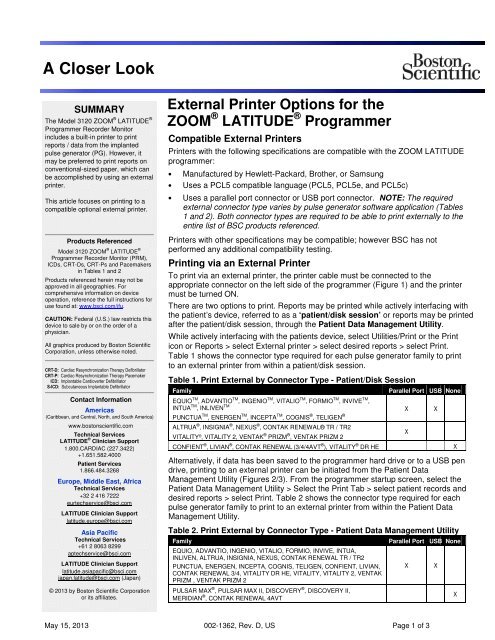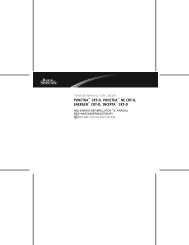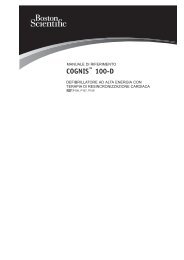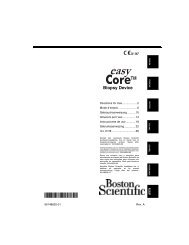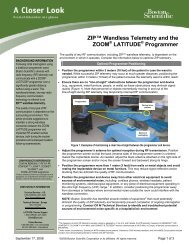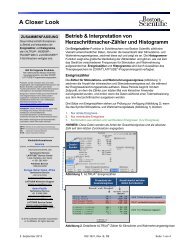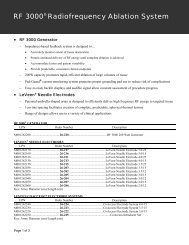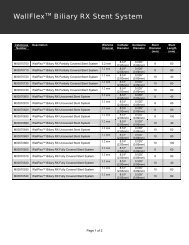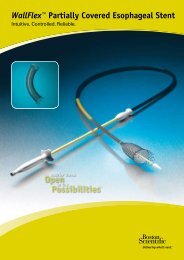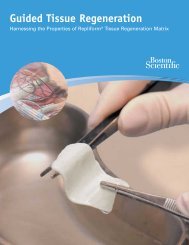External Printer Options for the ZOOM LATITUDE ... - Boston Scientific
External Printer Options for the ZOOM LATITUDE ... - Boston Scientific
External Printer Options for the ZOOM LATITUDE ... - Boston Scientific
You also want an ePaper? Increase the reach of your titles
YUMPU automatically turns print PDFs into web optimized ePapers that Google loves.
A Closer Look<br />
SUMMARY<br />
The Model 3120 <strong>ZOOM</strong> ® <strong>LATITUDE</strong> ®<br />
Programmer Recorder Monitor<br />
includes a built-in printer to print<br />
reports / data from <strong>the</strong> implanted<br />
pulse generator (PG). However, it<br />
may be preferred to print reports on<br />
conventional-sized paper, which can<br />
be accomplished by using an external<br />
printer.<br />
This article focuses on printing to a<br />
compatible optional external printer.<br />
Products Referenced<br />
Model 3120 <strong>ZOOM</strong> ® <strong>LATITUDE</strong> ®<br />
Programmer Recorder Monitor (PRM),<br />
ICDs, CRT-Ds, CRT-Ps and Pacemakers<br />
in Tables 1 and 2<br />
Products referenced herein may not be<br />
approved in all geographies. For<br />
comprehensive in<strong>for</strong>mation on device<br />
operation, reference <strong>the</strong> full instructions <strong>for</strong><br />
use found at: www.bsci.com/ifu.<br />
CAUTION: Federal (U.S.) law restricts this<br />
device to sale by or on <strong>the</strong> order of a<br />
physician.<br />
All graphics produced by <strong>Boston</strong> <strong>Scientific</strong><br />
Corporation, unless o<strong>the</strong>rwise noted.<br />
CRT-D: Cardiac Resynchronization Therapy Defibrillator<br />
CRT-P: Cardiac Resynchronization Therapy Pacemaker<br />
ICD: Implantable Cardioverter Defibrillator<br />
S-ICD: Subcutaneous Implantable Defibrillator<br />
Contact In<strong>for</strong>mation<br />
Americas<br />
(Caribbean, and Central, North, and South America)<br />
www.bostonscientific.com<br />
Technical Services<br />
<strong>LATITUDE</strong> ® Clinician Support<br />
1.800.CARDIAC (227.3422)<br />
+1.651.582.4000<br />
Patient Services<br />
1.866.484.3268<br />
Europe, Middle East, Africa<br />
Technical Services<br />
+32 2 416 7222<br />
eurtechservice@bsci.com<br />
<strong>LATITUDE</strong> Clinician Support<br />
latitude.europe@bsci.com<br />
Asia Pacific<br />
Technical Services<br />
+61 2 8063 8299<br />
aptechservice@bsci.com<br />
<strong>LATITUDE</strong> Clinician Support<br />
latitude.asiapacific@bsci.com<br />
japan.latitude@bsci.com (Japan)<br />
© 2013 by <strong>Boston</strong> <strong>Scientific</strong> Corporation<br />
or its affiliates.<br />
<strong>External</strong> <strong>Printer</strong> <strong>Options</strong> <strong>for</strong> <strong>the</strong><br />
<strong>ZOOM</strong> ® <strong>LATITUDE</strong> ® Programmer<br />
Compatible <strong>External</strong> <strong>Printer</strong>s<br />
<strong>Printer</strong>s with <strong>the</strong> following specifications are compatible with <strong>the</strong> <strong>ZOOM</strong> <strong>LATITUDE</strong><br />
programmer:<br />
• Manufactured by Hewlett-Packard, Bro<strong>the</strong>r, or Samsung<br />
• Uses a PCL5 compatible language (PCL5, PCL5e, and PCL5c)<br />
• Uses a parallel port connector or USB port connector. NOTE: The required<br />
external connector type varies by pulse generator software application (Tables<br />
1 and 2). Both connector types are required to be able to print externally to <strong>the</strong><br />
entire list of BSC products referenced.<br />
<strong>Printer</strong>s with o<strong>the</strong>r specifications may be compatible; however BSC has not<br />
per<strong>for</strong>med any additional compatibility testing.<br />
Printing via an <strong>External</strong> <strong>Printer</strong><br />
To print via an external printer, <strong>the</strong> printer cable must be connected to <strong>the</strong><br />
appropriate connector on <strong>the</strong> left side of <strong>the</strong> programmer (Figure 1) and <strong>the</strong> printer<br />
must be turned ON.<br />
There are two options to print. Reports may be printed while actively interfacing with<br />
<strong>the</strong> patient’s device, referred to as a ‘patient/disk session’ or reports may be printed<br />
after <strong>the</strong> patient/disk session, through <strong>the</strong> Patient Data Management Utility.<br />
While actively interfacing with <strong>the</strong> patients device, select Utilities/Print or <strong>the</strong> Print<br />
icon or Reports > select <strong>External</strong> printer > select desired reports > select Print.<br />
Table 1 shows <strong>the</strong> connector type required <strong>for</strong> each pulse generator family to print<br />
to an external printer from within a patient/disk session.<br />
Table 1. Print <strong>External</strong> by Connector Type - Patient/Disk Session<br />
Family<br />
Parallel Port USB None<br />
EQUIO TM , ADVANTIO TM , INGENIO TM , VITALIO TM , FORMIO TM , INVIVE TM ,<br />
INTUA TM , INLIVEN TM<br />
X X<br />
PUNCTUA TM , ENERGEN TM , INCEPTA TM , COGNIS ® , TELIGEN ®<br />
ALTRUA ® , INSIGNIA ® , NEXUS ® , CONTAK RENEWAL® TR / TR2<br />
VITALITY ® , VITALITY 2, VENTAK ® PRIZM ® , VENTAK PRIZM 2<br />
CONFIENT ® , LIVIAN ® , CONTAK RENEWAL (3/4/4AVT ® ), VITALITY ® DR HE<br />
Alternatively, if data has been saved to <strong>the</strong> programmer hard drive or to a USB pen<br />
drive, printing to an external printer can be initiated from <strong>the</strong> Patient Data<br />
Management Utility (Figures 2/3). From <strong>the</strong> programmer startup screen, select <strong>the</strong><br />
Patient Data Management Utility > Select <strong>the</strong> Print Tab > select patient records and<br />
desired reports > select Print. Table 2 shows <strong>the</strong> connector type required <strong>for</strong> each<br />
pulse generator family to print to an external printer from within <strong>the</strong> Patient Data<br />
Management Utility.<br />
Table 2. Print <strong>External</strong> by Connector Type - Patient Data Management Utility<br />
Family<br />
EQUIO, ADVANTIO, INGENIO, VITALIO, FORMIO, INVIVE, INTUA,<br />
INLIVEN, ALTRUA, INSIGNIA, NEXUS, CONTAK RENEWAL TR / TR2<br />
PUNCTUA, ENERGEN, INCEPTA, COGNIS, TELIGEN, CONFIENT, LIVIAN,<br />
CONTAK RENEWAL 3/4, VITALITY DR HE, VITALITY, VITALITY 2, VENTAK<br />
PRIZM , VENTAK PRIZM 2<br />
PULSAR MAX ® , PULSAR MAX II, DISCOVERY ® , DISCOVERY II,<br />
MERIDIAN ® , CONTAK RENEWAL 4AVT<br />
X<br />
Parallel Port USB None<br />
X<br />
X<br />
X<br />
X<br />
May 15, 2013 002-1362, Rev. D, US Page 1 of 3
Frequently Asked Questions<br />
Where do I connect <strong>the</strong> printer cable to <strong>the</strong> <strong>ZOOM</strong> LATTIUDE programmer?<br />
A parallel port and two USB ports are located on <strong>the</strong> left side of <strong>the</strong> programmer. Select a printer cable and<br />
corresponding port, depending on device family and print method chosen (see Figure 1 and Tables 1 / 2).<br />
Figure 1. Left side of Programmer [1] On/Off button [2] <strong>External</strong> <strong>Printer</strong> Connector (Parallel port) [3] Two USB<br />
ports<br />
Which printer models have been tested and verified as compatible with <strong>the</strong> <strong>ZOOM</strong> <strong>LATITUDE</strong> programmer?<br />
Contact Hewlett-Packard, Bro<strong>the</strong>r, or Samsung Customer Support. State that you need a printer with a PCL5<br />
compatible print language, and connectivity via parallel port or USB. NOTE: The required external connector type varies<br />
by pulse generator software application (Tables 1 and 2). Both connector types are required to be able to print<br />
externally to <strong>the</strong> entire list of BSC products referenced.<br />
Where do I access <strong>the</strong> Patient Data Management Utility?<br />
The Patient Data Management Utility can be accessed from <strong>the</strong> programmer Startup screen (Figure 2). Printing is<br />
accomplished by accessing <strong>the</strong> Print Tab (Figure 3).<br />
Figure 2. Programmer Startup Screen<br />
Figure 3. Patient Data Management Utility Print Tab<br />
Does <strong>the</strong> <strong>ZOOM</strong> <strong>LATITUDE</strong> PRM support color printing?<br />
No. The <strong>ZOOM</strong> <strong>LATITUDE</strong> PRM does not support printing in color.<br />
Can an external printer be used while <strong>the</strong> software application is in Demo Mode?<br />
Yes. If <strong>the</strong> PG software application has <strong>the</strong> ability to print externally (Table 1 / 2), it will print demo data while in Demo<br />
Mode.<br />
May 15, 2013 002-1362, Rev. D, US Page 2 of 3
Frequently Asked Questions<br />
Does printing to an external printer meet electrical safety standards?<br />
<strong>Boston</strong> <strong>Scientific</strong> Instructions <strong>for</strong> Use include <strong>the</strong> following precaution regarding optional external equipment (e.g.,<br />
printers):<br />
PRECAUTION: Although any optional external equipment connected to <strong>the</strong> programmer meets leakage-current<br />
requirements <strong>for</strong> commercial products, it may not meet <strong>the</strong> more stringent leakage requirements <strong>for</strong> medical products.<br />
Consequently, <strong>the</strong> external printing equipment must be kept outside <strong>the</strong> patient environment (at least 1.5 m [4.9 feet]<br />
away from <strong>the</strong> patient). (Operator’s Manual <strong>ZOOM</strong> <strong>LATITUDE</strong> PRM 357435-094 EN).<br />
Additionally, equipment connected to <strong>the</strong> external connections must comply with applicable standards (e.g., IEC/EN<br />
60950-1 <strong>for</strong> data processing equipment and IEC/EN 60601-1 <strong>for</strong> medical equipment).<br />
WARNING: The use of any cables or accessories with <strong>the</strong> programmer o<strong>the</strong>r than those specified by <strong>Boston</strong> <strong>Scientific</strong><br />
in <strong>the</strong> Instructions <strong>for</strong> Use (IFU) may result in increased emissions or decreased immunity of <strong>the</strong> programmer. Anyone<br />
connecting such cables or accessories to <strong>the</strong> programmer may be configuring a medical system and is responsible to<br />
ensure that <strong>the</strong> system complies with <strong>the</strong> requirements of IEC/EN 60601-1, Clause 16 <strong>for</strong> medical electrical systems.<br />
If you require fur<strong>the</strong>r assistance, contact <strong>Boston</strong> <strong>Scientific</strong> Technical Services.<br />
May 15, 2013 002-1362, Rev. D, US Page 3 of 3
<strong>ZOOM</strong> ® <strong>LATITUDE</strong> ® Programming System from <strong>Boston</strong> <strong>Scientific</strong><br />
Intended Use<br />
The Model 3120 Programmer/Recorder/Monitor (PRM) is intended to be used as a complete system to communicate with Guidant or <strong>Boston</strong> <strong>Scientific</strong> implantable pulse generators. The software in use<br />
controls all communication functions <strong>for</strong> <strong>the</strong> pulse generator. For detailed software application instructions, refer to <strong>the</strong> System Guide <strong>for</strong> <strong>the</strong> Guidant or <strong>Boston</strong> <strong>Scientific</strong> pulse generator being<br />
interrogated.<br />
Contraindications<br />
The Model 3120 PRM is contraindicated <strong>for</strong> use with any pulse generator o<strong>the</strong>r than a Guidant or <strong>Boston</strong> <strong>Scientific</strong> device. For contraindications <strong>for</strong> use related to <strong>the</strong> Guidant or <strong>Boston</strong> <strong>Scientific</strong> pulse<br />
generator, refer to <strong>the</strong> System Guide <strong>for</strong> <strong>the</strong> Guidant or <strong>Boston</strong> <strong>Scientific</strong> pulse generator being interrogated.<br />
Warnings<br />
There are no warnings associated with this programming system.<br />
Precautions<br />
For specific in<strong>for</strong>mation on precautions, read <strong>the</strong> following sections of <strong>the</strong> product labeling: General, Preparation<br />
<strong>for</strong> Use, Maintenance and Handling.<br />
Adverse Effects<br />
None known.<br />
Refer to <strong>the</strong> product labeling <strong>for</strong> specific indications, contraindications, warnings/precautions and adverse effects. Rx only.<br />
(Rev. E)<br />
CRT-D System from <strong>Boston</strong> <strong>Scientific</strong> – COGNIS ® or older<br />
Indications and Usage<br />
These <strong>Boston</strong> <strong>Scientific</strong> Cardiac Resynchronization Therapy Defibrillators (CRT-Ds) are indicated <strong>for</strong> patients with heart failure who receive stable optimal pharmacologic <strong>the</strong>rapy (OPT) <strong>for</strong> heart failure<br />
and who meet any one of <strong>the</strong> following classifications:<br />
• Moderate to severe heart failure (NYHA Class III-IV) with EF ≤ 35% and QRS duration ≥ 120 ms<br />
• Left bundle branch block (LBBB) with QRS ≥ 130 ms, EF ≤ 30%, and mild (NYHA Class II) ischemic or nonischemic heart failure or asymptomatic (NYHA Class I) ischemic heart failure<br />
Contraindications<br />
There are no contraindications <strong>for</strong> this device.<br />
Warnings<br />
Read <strong>the</strong> product labeling thoroughly be<strong>for</strong>e implanting <strong>the</strong> pulse generator to avoid damage to <strong>the</strong> system. For single patient use only. Do not reuse, reprocess, or resterilize. Program <strong>the</strong> pulse generator<br />
Tachy Mode to Off during implant, explant or postmortem procedures. Always have sterile external and internal defibrillator protection available during implant and electrophysiologic testing. Ensure that<br />
an external defibrillator and medical personnel skilled in CPR are present during post-implant device testing. Advise patients to seek medical guidance be<strong>for</strong>e entering environments that could adversely<br />
affect <strong>the</strong> operation of <strong>the</strong> active implantable medical device, including areas protected by a warning notice that prevents entry by patients who have a pulse generator. Do not expose a patient to MRI<br />
scanning. Do not subject a patient with an implanted pulse generator to dia<strong>the</strong>rmy, Do not use atrialtracking modes in patients with chronic refractory atrial tachyarrhythmias. Do not use atrial-only modes<br />
in patients with heart failure. LV lead dislodgment to a position near <strong>the</strong> atria can result in atrial oversensing and LV pacing inhibition. Physicians should use medical discretion when implanting this device<br />
in patients who present with slow VT. Do not kink, twist or braid <strong>the</strong> lead with o<strong>the</strong>r leads. Do not use defibrillation patch leads with <strong>the</strong> CRT-D system. Do not use this pulse generator with ano<strong>the</strong>r pulse<br />
generator. For Patient Triggered Monitor (PTM) feature, make sure <strong>the</strong> feature is enabled prior to sending <strong>the</strong> patient home with a magnet. Once <strong>the</strong> PTM feature has been triggered and <strong>the</strong> magnet<br />
response programming is set to inhibit <strong>the</strong>rapy, <strong>the</strong> patient should not reapply <strong>the</strong> magnet.<br />
Precautions<br />
For specific in<strong>for</strong>mation on precautions, refer to <strong>the</strong> following sections of <strong>the</strong> product labeling: clinical considerations; sterilization, storage and handling; implant and device programming; follow-up testing;<br />
explant and disposal; environmental and medical <strong>the</strong>rapy hazards; hospital and medical environments; home and occupational environments. Advise patients to avoid sources of electromagnetic<br />
interference (EMI) because EMI may cause <strong>the</strong> pulse generator to deliver inappropriate <strong>the</strong>rapy or inhibit appropriate <strong>the</strong>rapy.<br />
Potential Adverse Events<br />
Potential adverse events from implantation of <strong>the</strong> CRT-D system include, but are not limited to, <strong>the</strong> following: allergic/physical/physiologic reaction, death, erosion/migration, fibrillation or o<strong>the</strong>r arrhythmias,<br />
lead or accessory breakage (fracture/insulation/lead tip), hematoma/seroma, inappropriate or inability to provide <strong>the</strong>rapy (shocks/pacing/sensing), infection, procedure related, and component failure.<br />
Patients may develop psychological intolerance to a pulse generator system and may experience fear of shocking, fear of device failure, or imagined shocking. In rare cases severe complications or<br />
device failures can occur.<br />
Refer to <strong>the</strong> product labeling <strong>for</strong> specific indications, contraindications, warnings/precautions and adverse events. Rx only.<br />
(Rev. R)<br />
CRT-D Systems from <strong>Boston</strong> <strong>Scientific</strong> – PUNCTUA TM , ENERGEN TM , and INCEPTA TM<br />
Indications and Usage<br />
The PUNCTUATM, ENERGENTM, and INCEPTATM Cardiac Resynchronization Therapy Defibrillators (CRT-Ds) are indicated <strong>for</strong> patients with heart failure who receive stable optimal pharmacologic<br />
<strong>the</strong>rapy (OPT) <strong>for</strong> heart failure and who meet any one of <strong>the</strong> following classifications:<br />
• Moderate to severe heart failure (NYHA Class III-IV) with EF ≤ 35% and QRS duration ≥ 120 ms<br />
• Left bundle branch block (LBBB) with QRS ≥ 130 ms, EF ≤ 30%, and mild (NYHA Class II) ischemic or nonischemic heart failure or asymptomatic (NYHA Class I) ischemic heart failure<br />
Contraindications<br />
There are no contraindications <strong>for</strong> this device.<br />
Warnings<br />
Read <strong>the</strong> product labeling thoroughly be<strong>for</strong>e implanting <strong>the</strong> pulse generator to avoid damage to <strong>the</strong> system. For single patient use only. Do not reuse, reprocess, or resterilize. Program <strong>the</strong> pulse generator<br />
Tachy Mode to Off during implant, explant or postmortem procedures. Always have external defibrillator protection available during implant and electrophysiologic testing. Ensure that an external<br />
defibrillator and medical personnel skilled in CPR are present during post-implant device testing. Advise patients to seek medical guidance be<strong>for</strong>e entering environments that could adversely affect <strong>the</strong><br />
operation of <strong>the</strong> active implantable medical device, including areas protected by a warning notice that prevents entry by patients who have a pulse generator. Do not expose a patient to MRI scanning. Do<br />
not subject a patient with an implanted pulse generator to dia<strong>the</strong>rmy, Do not use atrial-tracking modes in patients with chronic refractory atrial tachyarrhythmias. Do not use atrial-only modes in patients<br />
with heart failure. LV lead dislodgment to a position near <strong>the</strong> atria can result in atrial oversensing and LV pacing inhibition. Physicians should use medical discretion when implanting this device in patients<br />
who present with slow VT. Do not kink, twist or braid <strong>the</strong> lead with o<strong>the</strong>r leads. Do not use defibrillation patch leads with <strong>the</strong> CRT-D system. Do not use this pulse generator with ano<strong>the</strong>r pulse generator.<br />
For Patient Triggered Monitor (PTM) feature, make sure <strong>the</strong> feature is enabled prior to sending <strong>the</strong> patient home with a magnet. Once <strong>the</strong> PTM feature has been triggered and <strong>the</strong> magnet response<br />
programming is set to inhibit <strong>the</strong>rapy, <strong>the</strong> patient should not reapply <strong>the</strong> magnet. For DF4-LLHH or DF4-LLHO leads, use caution handling <strong>the</strong> lead terminal when <strong>the</strong> Connector Tool is not present on <strong>the</strong><br />
lead and do not directly contact <strong>the</strong> lead terminal with any surgical instruments or electrical connections such as PSA (alligator) clips, ECG connections, <strong>for</strong>ceps, hemostats, and clamps. Do not contact<br />
any o<strong>the</strong>r portion of <strong>the</strong> DF4-LLHH or DF4-LLHO lead terminal, o<strong>the</strong>r than <strong>the</strong> terminal pin even when <strong>the</strong> lead cap is in place.<br />
Precautions<br />
For specific in<strong>for</strong>mation on precautions, refer to <strong>the</strong> following sections of <strong>the</strong> product labeling: clinical considerations; sterilization and storage; implantation; device programming; follow-up testing; explant<br />
and disposal; environmental and medical <strong>the</strong>rapy hazards; hospital and medical environments; home and occupational environments; and supplemental precautionary in<strong>for</strong>mation. Advise patients to avoid<br />
sources of electromagnetic interference (EMI) because EMI may cause <strong>the</strong> pulse generator to deliver inappropriate <strong>the</strong>rapy or inhibit appropriate <strong>the</strong>rapy.<br />
Potential Adverse Events<br />
Potential adverse events from implantation of <strong>the</strong> CRT-D system include, but are not limited to, <strong>the</strong> following: allergic/physical/physiologic reaction, death, erosion/migration, fibrillation or o<strong>the</strong>r arrhythmias,<br />
lead or accessory breakage (fracture/insulation/lead tip), hematoma/seroma, inappropriate or inability to provide <strong>the</strong>rapy (shocks/pacing/sensing), infection, procedure related, and component failure.<br />
Patients may develop psychological intolerance to a pulse generator system and may experience fear of shocking, fear of device failure, or imagined shocking. In rare cases severe complications or<br />
device failures can occur.<br />
Refer to <strong>the</strong> product labeling <strong>for</strong> specific indications, contraindications, warnings/precautions and adverse events. Rx only.<br />
(Rev. B)<br />
ADDENDUM TO: 002-1362, Rev. D, US<br />
Most Current Brief Summaries found @ www.http://www.bostonscientific.com/
CRT-P System from <strong>Boston</strong> <strong>Scientific</strong> – Contak Renewal ® TR<br />
Indications<br />
The CONTAK RENEWAL TR pulse generator is indicated <strong>for</strong> patients who have moderate to severe heart failure (NYHA Class III/IV) including left ventricular dysfunction (EF ≤ 35%) and QRS duration ≥<br />
120 ms and remain symptomatic despite stable, optimal heart failure drug <strong>the</strong>rapy (as defined in <strong>the</strong> clinical trials section in <strong>the</strong> System Guide). These devices provide atrial-ventricular tracking modes to<br />
help preserve AV synchrony and adaptive-rate pacing <strong>for</strong> patients who would benefit from adjusted pacing rates concurrent with physical activity.<br />
Contraindications<br />
These devices are contraindicated in patients who have a separate implanted cardioverter-defibrillator (ICD). Single-chamber atrial pacing is contraindicated in patients with impaired AV nodal conduction.<br />
Atrial tracking modes are contraindicated <strong>for</strong> patients with chronic refractory atrial tachyarrhythmias (atrial fibrillation or flutter), which might trigger ventricular pacing. Asynchronous pacing is<br />
contraindicated in <strong>the</strong> presence (or likelihood) of competition between paced and intrinsic rhythms.<br />
Warnings<br />
Read <strong>the</strong> product labeling thoroughly be<strong>for</strong>e implanting <strong>the</strong> pulse generator to avoid damage to <strong>the</strong> system. For single patient use only Do not reuse, reprocess, or resterilize. Such damage can result in<br />
patient injury or death. Do not expose a patient to MRI device scanning. Do not expose a patient with an activated implanted pulse generator to dia<strong>the</strong>rmy. Do not use atrial-only modes in patients with<br />
heart failure. The clinical outcomes <strong>for</strong> patients with chronic refractory atrial tachyarrhythmias are not fully known. Safety and effectiveness studies have not been conducted. If a chronic refractory atrial<br />
tachyarrhythmia develops in a patient with <strong>the</strong>se devices, do not use dualchamber or single-chamber atrial pacing. Left ventricular (LV) lead dislodgment to a position near <strong>the</strong> atria can result in atrial<br />
oversensing and LV pacing inhibition.<br />
Precautions<br />
For specific in<strong>for</strong>mation on precautions, refer to <strong>the</strong> following sections of <strong>the</strong> product labeling: clinical considerations; sterilization, storage and handling; implantation and device programming; pulse<br />
generator explant and disposal; environmental and medical <strong>the</strong>rapy hazards. Advise patients to avoid sources of electromagnetic interference (EMI) because EMI may cause <strong>the</strong> pulse generator to deliver<br />
inappropriate <strong>the</strong>rapy or inhibit appropriate <strong>the</strong>rapy.<br />
Potential Adverse Events<br />
Potential adverse events include, but are not limited to, <strong>the</strong> following: allergic/physical/physiologic reaction, death, erosion/migration, fibrillation or o<strong>the</strong>r arrhythmias, lead or accessory breakage<br />
(fracture/insulation/lead tip), hematoma/seroma, inappropriate or inability to provide <strong>the</strong>rapy (pacing/sensing), infection, lead tip de<strong>for</strong>mation and/or breakage, procedure related, and component failure. In<br />
rare cases severe complications or device failures can occur.<br />
Refer to <strong>the</strong> product labeling <strong>for</strong> specific indications, contraindications, warnings/ precautions and adverse events. Rx only.<br />
(Rev. M)<br />
CRT-P Systems from <strong>Boston</strong> <strong>Scientific</strong> - INVIVE TM<br />
Indications<br />
The Invive cardiac resynchronization <strong>the</strong>rapy pacemaker (CRT-Ps) is indicated <strong>for</strong> patients who have moderate to severe heart failure (NYHA Class III/IV) including left ventricular dysfunction (EF ≤ 35%)<br />
and QRS duration ≥ 120 ms and remain symptomatic despite stable, optimal pharmacologic <strong>the</strong>rapy <strong>for</strong> heart failure. Atrial tracking modes are also indicated <strong>for</strong> patients who may benefit from<br />
maintenance of AV synchrony. Adaptive-rate pacing is indicated <strong>for</strong> patients exhibiting chronotropic incompetence and who would benefit from increased pacing rates concurrent with increases in physical<br />
activity.<br />
Contraindications<br />
These devices are contraindicated in patients who have a separate implanted cardioverter-defibrillator (ICD). Single-chamber atrial pacing is contraindicated in patients with impaired AV nodal conduction.<br />
Atrial tracking modes are contraindicated <strong>for</strong> patients with chronic refractory atrial tachyarrhythmias (atrial fibrillation or flutter), which might trigger ventricular pacing. Asynchronous pacing is<br />
contraindicated in <strong>the</strong> presence (or likelihood) of competition between paced and intrinsic rhythms.<br />
Warnings<br />
Read <strong>the</strong> product labeling thoroughly be<strong>for</strong>e implanting <strong>the</strong> pulse generator to avoid damage to <strong>the</strong> system. For single use only. Do not reuse, reprocess or resterilize. Always have external defibrillation<br />
protection available during implant and electrophysiologic testing. Do not use this pulse generator with ano<strong>the</strong>r pulse generator. In response to applicable nonrecoverable or repeat fault conditions, <strong>the</strong><br />
pulse generator will switch irreversible to Safety Core operation. Do not kink, twist, or braid leads. Do not use atrial tracking modes in patients with chronic refractory atrial tachyarrhythmias. Do not use<br />
atrial only modes in patients with heart failure. In devices with <strong>the</strong> lead safety switch programmed to On, <strong>the</strong> lead polarity will switch to unipolar in <strong>the</strong> presence of a lead impedance of ≤ 200 or ≥ 2000 Ω. If<br />
programmed to a fixed atrial sensitivity value of 0.15 mV, <strong>the</strong> pulse generator may be more susceptible to electromagnetic interference. Advise patients to seek medical guidance be<strong>for</strong>e entering<br />
environments that could adversely affect <strong>the</strong> operation of <strong>the</strong> active implantable medical device. Do not expose a patient to MRI scanning. Do not subject a patient with an implanted pulse generator<br />
and/or lead to dia<strong>the</strong>rmy. Left ventricular (LV) lead dislodgment to a position near <strong>the</strong> atria can result in atrial oversensing and LV pacing inhibition.<br />
Precautions<br />
For specific in<strong>for</strong>mation on precautions, refer to <strong>the</strong> following sections of <strong>the</strong> product labeling: clinical considerations; sterilization and storage; implantation; device programming; environmental and<br />
medical <strong>the</strong>rapy hazards; hospital and medical environments ; home and occupational environments; follow up testing; explant and disposal; and supplemental precautionary in<strong>for</strong>mation. Advise patients<br />
to avoid sources of electric or magnetic interference (EMI) because EMI may cause <strong>the</strong> pulse generator to deliver inappropriate <strong>the</strong>rapy or inhibit appropriate <strong>the</strong>rapy.<br />
Potential Adverse Events<br />
Potential adverse events include, but are not limited to, <strong>the</strong> following: allergic/physical/physiologic reaction, death, erosion/migration, fibrillation or o<strong>the</strong>r arrhythmias, lead or accessory breakage<br />
(fracture/insulation/lead tip), hematoma/seroma, inappropriate or inability to provide <strong>the</strong>rapy (pacing/sensing), infection, lead tip de<strong>for</strong>mation and/or breakage, procedure related, and component failure. In<br />
rare cases severe complications or device failures can occur.<br />
Refer to <strong>the</strong> product labeling <strong>for</strong> specific indications, contraindications, warnings/ precautions and adverse events. Rx only.<br />
(Rev. A)<br />
ICD Systems from <strong>Boston</strong> <strong>Scientific</strong> – PUNCTUA, ENERGEN, and INCEPTA<br />
ICD Indications and Usage<br />
PUNCTUA TM , ENERGEN TM , and INCEPTA TM ICDs are intended to provide ventricular antitachycardia pacing and ventricular defibrillation <strong>for</strong> automated treatment of life-threatening ventricular<br />
arrhythmias.<br />
Contraindications<br />
Use of <strong>the</strong>se ICD systems are contraindicated in: Patients whose ventricular tachyarrhythmias may have reversible cause, such as 1) digitalis intoxication, 2) electrolyte imbalance, 3) hypoxia, or 4)<br />
sepsis, or whose ventricular tachyarrhythmias have a transient cause, such as 1) acute myocardial infarction, 2) electrocution, or 3) drowning. Patients who have a unipolar pacemaker.<br />
Warnings<br />
Read <strong>the</strong> product labeling thoroughly be<strong>for</strong>e implanting <strong>the</strong> pulse generator to avoid damage to <strong>the</strong> ICD system. For single patient use only. Do not reuse, reprocess, or resterilize. Program <strong>the</strong> pulse<br />
generator ventricular Tachy Mode to Off during implant, explant or post-mortem procedures. Always have external defibrillator protection available during implant and electrophysiologic testing. Ensure<br />
that an external defibrillator and medical personnel skilled in cardiopulmonary resuscitation (CPR) are present during post-implant device testing. Patients should seek medical guidance be<strong>for</strong>e entering<br />
environments that could adversely affect <strong>the</strong> operation of <strong>the</strong> active implantable medical device, including areas protected by a warning notice that prevents entry by patients who have a pulse generator.<br />
Do not expose a patient to MRI scanning. Do not subject a patient with an implanted pulse generator to dia<strong>the</strong>rmy. Do not use atrial tracking modes in patients with chronic refractory atrial<br />
tachyarrhythmias. Do not use this pulse generator with ano<strong>the</strong>r pulse generator. Do not kink, twist or braid lead with o<strong>the</strong>r leads. For Patient Triggered Monitor (PTM) feature, make sure <strong>the</strong> feature is<br />
enabled prior to sending <strong>the</strong> patient home with a magnet. Once <strong>the</strong> PTM feature has been triggered and <strong>the</strong> magnet response programming is set to inhibit <strong>the</strong>rapy, <strong>the</strong> patient should not reapply <strong>the</strong><br />
magnet. For DF4-LLHH or DF4-LLHO leads, use caution handling <strong>the</strong> lead terminal when <strong>the</strong> Connector Tool is not present on <strong>the</strong> lead and do not directly contact <strong>the</strong> lead terminal with any surgical<br />
instruments or electrical connections such as PSA (alligator) clips, ECG connections, <strong>for</strong>ceps, hemostats, and clamps. Do not contact any o<strong>the</strong>r portion of <strong>the</strong> DF4-LLHH or DF4-LLHO lead terminal, o<strong>the</strong>r<br />
than <strong>the</strong> terminal pin even when <strong>the</strong> lead cap is in place.<br />
Precautions<br />
For specific in<strong>for</strong>mation on precautions, refer to <strong>the</strong> following sections of <strong>the</strong> product labeling: clinical considerations; sterilization and storage; implantation; device programming; environmental and<br />
medical <strong>the</strong>rapy hazards; hospital and medical environments; home and occupational environments follow-up testing; explant and disposal; supplemental precautionary in<strong>for</strong>mation. Advise patients to<br />
avoid sources of electromagnetic interference (EMI).<br />
Potential Adverse Events<br />
Potential adverse events from implantation of <strong>the</strong> ICD system include, but are not limited to, <strong>the</strong> following: allergic/physical/physiologic reaction, death, erosion/migration, fibrillation or o<strong>the</strong>r arrhythmias,<br />
lead or accessory breakage (fracture/insulation/lead tip), hematoma/seroma, inappropriate or inability to provide <strong>the</strong>rapy (shocks/pacing/sensing), infection, procedure related, psychologic intolerance to<br />
an ICD system – patients susceptible to frequent shocks despite antiarrhythmic medical management/imagined shocking, and component failure. In rare cases severe complications or device failures can<br />
occur.<br />
Refer to <strong>the</strong> product labeling <strong>for</strong> specific indications, contraindications, warnings/ precautions and adverse events. Rx only.<br />
(Rev. B)<br />
ADDENDUM TO: 002-1362, Rev. D, US<br />
Most Current Brief Summaries found @ www.http://www.bostonscientific.com/
ICD Systems from <strong>Boston</strong> <strong>Scientific</strong> –TELIGEN ®<br />
ICD Indications and Usage<br />
ICDs are intended to provide ventricular antitachycardia pacing and ventricular defibrillation <strong>for</strong> automated treatment of life-threatening ventricular arrhythmias. ICDs (i.e. Vitality AVT) with atrial <strong>the</strong>rapies<br />
are also intended to provide atrial antitachycardia pacing and atrial defibrillation treatment in patients who have or are at risk of developing atrial tachyarrhythmias.<br />
Contraindications<br />
Use of ICD systems are contraindicated in: Patients whose ventricular tachyarrhythmias may have reversible cause, such as 1) digitalis intoxication, 2) electrolyte imbalance, 3) hypoxia, or 4) sepsis, or<br />
whose ventricular tachyarrhythmias have a transient cause, such as 1) acute myocardial infarction, 2) electrocution, or 3) drowning. Patients who have a unipolar pacemaker.<br />
Warnings<br />
Read <strong>the</strong> product labeling thoroughly be<strong>for</strong>e implanting <strong>the</strong> pulse generator to avoid damage to <strong>the</strong> ICD system. For single patient use only, Do not reuse, reprocess, or resterilize. Program <strong>the</strong> pulse<br />
generator ventricular Tachy Mode to Off during implant, explant or post-mortem procedures. Always have external defibrillator protection available during implant and electrophysiologic testing. Ensure<br />
that an external defibrillator and medical personnel skilled in cardiopulmonary resuscitation (CPR) are present during post-implant device testing. Patients should seek medical guidance be<strong>for</strong>e entering<br />
environments that could adversely affect <strong>the</strong> operation of <strong>the</strong> active implantable medical device, including areas protected by a warning notice that prevents entry by patients who have a pulse generator.<br />
Do not expose a patient to MRI scanning. Do not subject a patient with an implanted pulse generator to dia<strong>the</strong>rmy. Do not use atrial tracking modes (or an AVT device) in patients with chronic refractory<br />
atrial tachyarrhythmias. Do not use this pulse generator with ano<strong>the</strong>r pulse generator. Do not kink, twist or braid lead with o<strong>the</strong>r leads. For Patient Triggered Monitor (PTM) feature, make sure <strong>the</strong> feature<br />
is enabled prior to sending <strong>the</strong> patient home with a magnet. Once <strong>the</strong> PTM feature has been triggered and <strong>the</strong> magnet response programming is set to inhibit <strong>the</strong>rapy, <strong>the</strong> patient should not reapply <strong>the</strong><br />
magnet.<br />
Precautions<br />
For specific in<strong>for</strong>mation on precautions, refer to <strong>the</strong> following sections of <strong>the</strong> product labeling: clinical considerations; sterilization and storage; implantation; device programming; environmental and<br />
medical <strong>the</strong>rapy hazards; hospital and medical environments; home and occupational environments follow-up testing; explant and disposal; supplemental precautionary in<strong>for</strong>mation. Advise patients to<br />
avoid sources of electromagnetic interference (EMI).<br />
Potential Adverse Events<br />
Potential adverse events from implantation of <strong>the</strong> ICD system include, but are not limited to, <strong>the</strong> following: allergic/physical/physiologic reaction, death, erosion/migration, fibrillation or o<strong>the</strong>r arrhythmias,<br />
lead or accessory breakage (fracture/insulation/lead tip), hematoma/seroma, inappropriate or inability to provide <strong>the</strong>rapy (shocks/pacing/sensing), infection, procedure related, psychologic intolerance to<br />
an ICD system – patients susceptible to frequent shocks despite antiarrhythmic medical management/imagined shocking, and component failure. In rare cases severe complications or device failures can<br />
occur.<br />
Refer to <strong>the</strong> product labeling <strong>for</strong> specific indications, contraindications, warnings/ precautions and adverse events. Rx only.<br />
(Rev. Q)<br />
Pacing Systems from <strong>Boston</strong> <strong>Scientific</strong> – INGENIO TM and ADVANTIO TM<br />
Indications<br />
Ingenio and Advantio indications include: symptomatic paroxysmal or permanent second- or third-degree AV block; symptomatic bilateral bundle branch block; symptomatic paroxysmal or transient sinus<br />
node dysfunction with or without associated AV conduction disorders; bradycardia-tachycardia syndrome, to prevent symptomatic bradycardia or some <strong>for</strong>ms of symptomatic tachyarrhythmias;<br />
neurovascular (vaso-vagal) syndromes or hypersensitive carotid sinus syndromes. Adaptive-rate pacing is indicated <strong>for</strong> patients exhibiting chronotropic incompetence and who may benefit from increased<br />
pacing rates concurrent with increases in minute ventilation and/or level of physical activity. Pacemakers’ dual-chamber and atrial tracking modes are also indicated <strong>for</strong> patients who may benefit from<br />
maintenance of AV synchrony. Dual-chamber modes are specifically indicated <strong>for</strong>: conduction disorders that require restoration of AV synchrony, including varying degrees of AV block; VVI intolerance<br />
(eg, pacemaker syndrome) in <strong>the</strong> presence of persistent sinus rhythm or low cardiac output or congestive heart failure secondary to bradycardia.<br />
Contraindications<br />
Pacemakers are contraindicated <strong>for</strong> <strong>the</strong> following patients under <strong>the</strong> circumstances listed: patients who have a separate implanted cardioverter-defibrillator (ICD); use of Minute Ventilation in patients with<br />
both unipolar atrial and ventricular leads; single-chamber atrial pacing in patients with impaired AV nodal conduction; atrial tracking modes <strong>for</strong> patients with chronic refractory atrial tachyarrhythmias (atrial<br />
fibrillation or flutter), which might trigger ventricular pacing; dual-chamber and single-chamber atrial pacing in patients with chronic refractory atrial tachyarrhythmias; asynchronous pacing in <strong>the</strong> presence<br />
(or likelihood) of competition between paced and intrinsic rhythms.<br />
Warnings<br />
Read <strong>the</strong> product labeling thoroughly be<strong>for</strong>e implanting <strong>the</strong> pulse generator to avoid damage to <strong>the</strong> system. For single use only. Do not reuse, reprocess or resterilize. Always have external defibrillation<br />
protection available during implant and electrophysiologic testing. Do not use this pulse generator with ano<strong>the</strong>r pulse generator. In response to applicable nonrecoverable or repeat fault conditions, <strong>the</strong><br />
pulse generator will switch irreversible to Safety Core operation. Do not kink, twist, or braid leads. Do not use atrial tracking modes in patients with chronic refractory atrial tachyarrhythmias. In devices with<br />
<strong>the</strong> lead safety switch programmed to On, <strong>the</strong> lead polarity will switch to unipolar in <strong>the</strong> presence of a lead impedance of ≤ 200 or ≥ 2000 Ω. If programmed to a fixed atrial sensitivity value of 0.15 mV, <strong>the</strong><br />
pulse generator may be more susceptible to electromagnetic interference. Advise patients to seek medical guidance be<strong>for</strong>e entering environments that could adversely affect <strong>the</strong> operation of <strong>the</strong> active<br />
implantable medical device. Do not expose a patient to MRI scanning. Do not subject a patient with an implanted pulse generator and/or lead to dia<strong>the</strong>rmy.<br />
Precautions<br />
For specific in<strong>for</strong>mation on precautions, refer to <strong>the</strong> following sections of <strong>the</strong> product labeling: clinical considerations; sterilization and storage; implantation; device programming; environmental and<br />
medical <strong>the</strong>rapy hazards; hospital and medical environments ; home and occupational environments; follow up testing; explant and disposal; supplemental precautionary in<strong>for</strong>mation. Advise patients to<br />
avoid sources of electric or magnetic interference (EMI) because EMI may cause <strong>the</strong> pulse generator to deliver inappropriate <strong>the</strong>rapy or inhibit appropriate <strong>the</strong>rapy.<br />
Potential Adverse Events<br />
Potential adverse events include, but are not limited to, <strong>the</strong> following: allergic/physical/physiologic reaction, death, erosion/migration, lead or accessory breakage (fracture/insulation/lead tip),<br />
hematoma/seroma, inappropriate or inability to provide <strong>the</strong>rapy (pacing/sensing), infection, procedure related, and component failure. In rare cases severe complications or device failures can occur.<br />
Refer to <strong>the</strong> product labeling <strong>for</strong> specific indications, contraindications, warnings/precautions and adverse events. Rx only.<br />
(Rev. A)<br />
Pacing Systems from <strong>Boston</strong> <strong>Scientific</strong> ALTRUA ® and INSIGNIA ®<br />
Indications<br />
Pacemaker indications include: symptomatic paroxysmal or permanent second- or third-degree AV block; symptomatic bilateral bundle branch block; symptomatic paroxysmal or transient sinus node<br />
dysfunction with or without associated AV conduction disorders; bradycardia-tachycardia syndrome, to prevent symptomatic bradycardia or some <strong>for</strong>ms of symptomatic tachyarrhythmias; neurovascular<br />
(vaso-vagal) syndromes or hypersensitive carotid sinus syndromes. Adaptive-rate pacing is indicated <strong>for</strong> patients who may benefit from increased pacing rates concurrent with increases in minute<br />
ventilation and/or level of physical activity. Pacemakers’ dual-chamber and atrial tracking modes are also indicated <strong>for</strong> patients who may benefit from maintenance of AV synchrony. Dual-chamber modes<br />
are specifically indicated <strong>for</strong>: conduction disorders that require restoration of AV synchrony, including varying degrees of AV block; VVI intolerance (eg, pacemaker syndrome) in <strong>the</strong> presence of persistent<br />
sinus rhythm.<br />
Contraindications<br />
Pacemakers are contraindicated <strong>for</strong> <strong>the</strong> following patients under <strong>the</strong> circumstances listed: patients with unipolar pacing leads or in MV mode with an implanted ICD because it may cause unwanted<br />
delivery or inhibition of ICD <strong>the</strong>rapy; use of <strong>the</strong> MV sensor in patients with only unipolar leads, because a bipolar lead is required in ei<strong>the</strong>r <strong>the</strong> atrium or <strong>the</strong> ventricle <strong>for</strong> MV detection (INSIGNIA® Plus,<br />
ALTRUA® 20/40); MV mode in patients with both unipolar atrial and ventricular leads (INSIGNIA® Ultra, ALTRUA® 60); single-chamber atrial pacing in patients with impaired AV nodal conduction; atrial<br />
tracking modes <strong>for</strong> patients with chronic refractory atrial tachyarrhythmias, which might trigger ventricular pacing; dual-chamber and single-chamber atrial pacing in patients with chronic refractory atrial<br />
tachyarrhythmias; asynchronous pacing in <strong>the</strong> presence (or likelihood) of competition between paced and intrinsic rhythms.<br />
Warnings<br />
Read <strong>the</strong> product labeling thoroughly be<strong>for</strong>e implanting <strong>the</strong> pulse generator to avoid damage to <strong>the</strong> system. For single use only-do not resterilize devices. Inappropriate sustained high-rate pacing occurred<br />
in <strong>the</strong> PULSAR MAX clinical study in 5 out of 130 patients with MV ON, 4 to 14 days after implant. If sustained high-rate pacing could be of concern, consider programming a reduced Max Sensor Rate<br />
or MV to Passive. These programming recommendations are intended to assure that MV calibration is evaluated and, if necessary, recalibrated (4 →ON) when <strong>the</strong> patient and pacing system have<br />
stabilized post implant. Continued monitoring of <strong>the</strong> MV sensor per<strong>for</strong>mance should be per<strong>for</strong>med at all follow-up visits until implant stabilization has occurred.<br />
Precautions<br />
For specific in<strong>for</strong>mation on precautions, refer to <strong>the</strong> following sections of <strong>the</strong> product labeling: MV sensor calibration at implant; clinical considerations; sterilization, storage and handling; lead evaluation<br />
and connection; implantation; programming and pacemaker operation; MV initialization; environmental and medical <strong>the</strong>rapy hazards; elevated pressure; explanted pacemakers. Advise patients to avoid<br />
sources of electric or magnetic interference (EMI). If <strong>the</strong> pacemaker inhibits or reverts to asynchronous operation at <strong>the</strong> programmed pacing rate or at <strong>the</strong> magnet rate while in <strong>the</strong> presence of <strong>the</strong> EMI,<br />
moving away from <strong>the</strong> source or turning it off will usually allow <strong>the</strong> pulse generator to return to its normal mode of operation.<br />
Potential Adverse Events<br />
Potential adverse events include, but are not limited to, <strong>the</strong> following: allergic/physical/physiologic reaction, death, erosion/migration, lead or accessory breakage (fracture/insulation/lead tip),<br />
hematoma/seroma, inappropriate or inability to provide <strong>the</strong>rapy (pacing/sensing), infection, procedure related, and component failure. In rare cases severe complications or device failures can occur.<br />
Refer to <strong>the</strong> product labeling <strong>for</strong> specific indications, contraindications, warnings/precautions and adverse events. Rx only.<br />
(Rev. Q)<br />
ADDENDUM TO: 002-1362, Rev. D, US<br />
Most Current Brief Summaries found @ www.http://www.bostonscientific.com/


